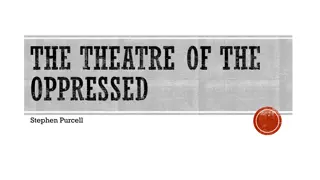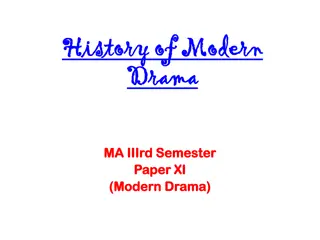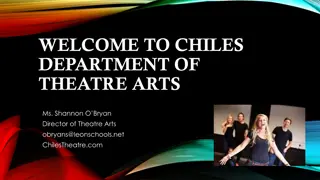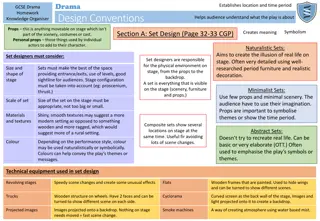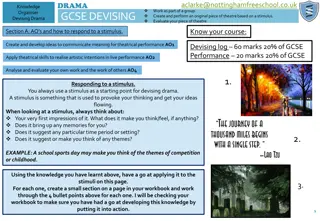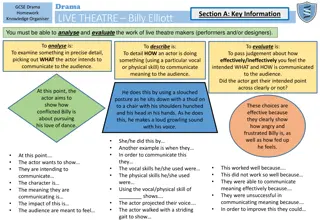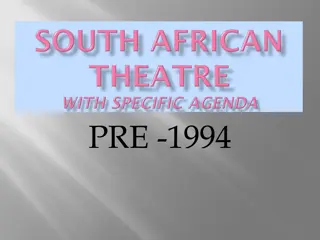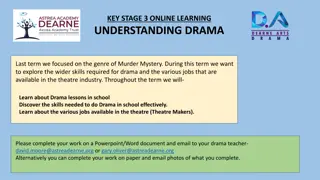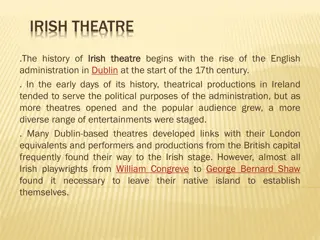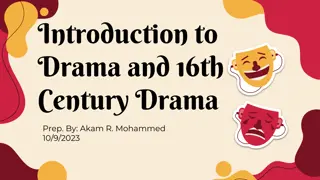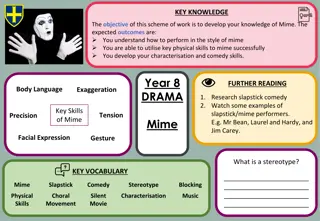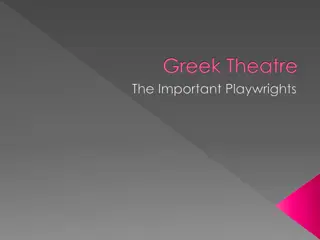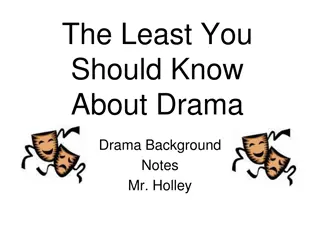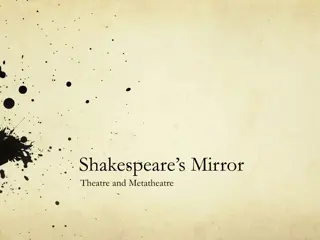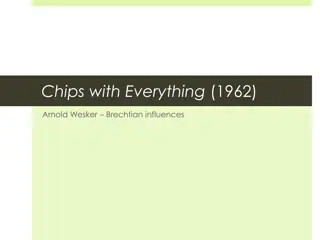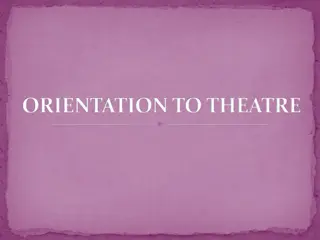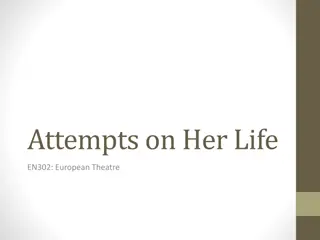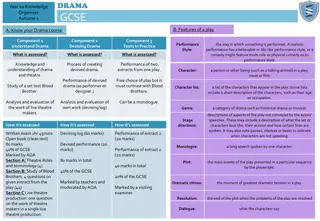Design Your Dream Theatre Project for Term 5 Drama
Embark on an exciting drama project for Term 5 by researching different types of theatres, selecting an auditorium, designing the interior and exterior of your theatre, and creating a mood board for decorating and furnishing. Get creative and pick a name that aligns with the theme of your envisioned theatre. Share your progress with Mrs. Crowther for feedback or showcase your work in person. Unleash your imagination and have fun with this interactive drama project!
Download Presentation

Please find below an Image/Link to download the presentation.
The content on the website is provided AS IS for your information and personal use only. It may not be sold, licensed, or shared on other websites without obtaining consent from the author. Download presentation by click this link. If you encounter any issues during the download, it is possible that the publisher has removed the file from their server.
E N D
Presentation Transcript
Putting on a Show! T5 Drama Project Hello! Here is your drama work for Term 5. There are lots of lessons but some will take less time than others. Please work through them at your own pace! You can either complete your work on a computer or on paper be as creative as you like! When you re finished, you can either share them with me on Teams or show me when we get back to school. Stay safe, Mrs Crowther
Lesson 1 Researching Theatres
Lesson 1 Task 1 - Researching Theatres Use the website below to help you research more about the different types of theatres we currently have in the UK. You will need to choose a theatre so that you can put on your show. http://www.theatrestrust.org.uk/ Click on Discover Theatres and then read through the Theatres FAQ s information. FAQ s means Frequently Asked Questions. There is loads of information contained here to help you decide what type of theatre you want to open. Once you have finished reading, answer the questions on the next slide. Key Skills Research Decision making Reasoning Justification
Lesson 1 What Key Spaces make up a theatre? Type your answer here: 1. Which type of auditoria would you like to use in your theatre? Why? Type your answer here 1.
Task: Search for 5 different images of the EXTERIOR buildings of different theatres. Try to choose theatres that look as different as possible. Post your images below and choose your favourite to become the exterior of your theatre.
Lesson 1 Sketch out your design ideas for the inside of your theatre. Create a MOOD BOARD for how you plan to decorate and furnish your theatre. Photograph it and upload it below, or just insert a screenshot of your doc. Key Word - MOOD BOARD A mood board is a visual map of images, materials, colours and ideas that you might have for your project, On your mood board, you might collate a colour scheme for the decor in your theatre as well as sketch out how it will look, what furniture you will have in the Front of House, what seats and the type of flooring you might put down.
Lesson 1 Now that you have chosen your exterior and completed your mood board, you should think of a name for your theatre. It should be something in keeping with the type of theatre you are hoping to create. For example, a sleek modern theatre shouldn t have a name like The Old Victoria . It needs a more modern name suited to the type of theatre like Curve . Once you have decided, write your name here:
Lesson 2 What show will you put on?
Lesson 2 Task 2: You need to decide which show you are going to put on. There are lots of things to consider when deciding which show to put on. What genre will you go for?. What kind of performance will draw in big crowds? What type of show are YOU interested in putting on? Theatre of the Absurd? Musical Theatre? Shakespeare? Key Skills Research Decision making Opinion Analysis
Key word - Genre Genre means type, style or category. Lesson 2 Research different genres of theatrical performances. Which genre do your favourite theatrical performances fall under? Write your answer here:
Lesson 2 Choose 5 different shows that you are interested in putting on. Conduct some market research - create a poll asking members of the public which show they would be most interested in seeing. You could create your poll using a google form and email it to people you know, or you could create a tick sheet and ask your friends and family. Why not make use of social media and create a facebook poll and find out what people are most interested in seeing? Finding this tricky? Look on the next slide for some ideas of popular Musicals. Key word - Market Research In this context, Market Research means finding out which shows the general public would like to see. There is no point in putting on a show that no one watches!
Lesson 2 Musical Theatre:
Lesson 2 Analyse your results: 1. Insert a copy of your results here: 1. Which show was the most popular? 1. Which genre does this show fall under?
Lesson 2 Decision time! The show my theatre is going to put on is:
Lesson 3 Researching your show!
Lesson 3 Researching your chosen show It is very important that you find out as much about the show you have chosen as possible before you attempt to bring it to the stage. Today s lesson is all about gathering information that you will need later on to help you in the process. For example - you need to know how many characters there are in your play so that you know how many actors to hire. You need to know what happens within your play so that you can advertise it to people. Key Skills Research Precis Developing drama vocabulary
Lesson 3 What is the plot or storyline of your play? Write a synopsis below Key Words: Plot: The main events of the play. Also known as the storyline. Basically, what happens in the play. Synopsis: This is a brief summary of over events of the play. Try to write it in a way that makes your play sound exciting and interesting. Include lots of adjectives!
Lesson 3 Find out about the characters in your play. How many characters are there? What are the characters names? Who are they in terms of the play? Are they the lead character or a supporting character? Are they good (the protagonist) or bad (the antagonist)? Task: On the next slide, create a mind map of all of the different characters within your chosen play. Try to include as much detail about them as you can. You could even use pictures from other productions of your chosen play to help you to visualise them. Use the questions above to help you. Key words: Protagonist and Antagonist These are nouns that refer to characters in a story. The protagonist is the main character, often a hero. The antagonist opposes the protagonist and is often a villain.
Lesson 3 Mindmap:
Lesson 4 Finding your actors!
Lesson 4 Week four and you have already designed your theatre, chosen your show and conducted essential research into your show. Well done! Next, you need to hire some actors!. Hiring actors is a tricky business - some theatres hire famous people because they already have a lot of fans. This is appealing to a theatre because it almost guarantees them an audience. Some theatres focus on discovering new talent. They key is to find the best actor for each particular role. How will you know who is the most suitable for the role? The key is to hold auditions. Key Skills Key word Auditions - an audition involves an actor showcasing their talents by performing a short scene or song from the play that they are auditioning for. Information text Developing drama vocabulary
Lesson 4 Most theatres will advertise their auditions on their websites and through agents, who often represent actors and recommend them for the role. It is important that the advertisement accurately describes what they are looking for in an actor. Take a look at the link below - it is a link to the Royal Shakespeare Company s website and the page contains an advertisement for their upcoming auditions for Matilda the Musical. http://uk.matildathemusical.com/about/auditions/
Lesson 4 Task: Create your own audition advert for your show. Remember to include lots of details about the SKILLS the actors need to have in order to be able to play a character within your show. Remember, all actors will wear costumes complete with hair and makeup, so it isn t essential that they look exactly like the character. However, you might need to stipulate some key physical features. For example, if one of your characters is an 8 year old girl, it wouldn t make any sense to audition 6ft tall, grown up man, would it? Put a copy of your advert on the next slide - either create it directly onto the slide or write it by hand and include a photograph. Fancy shaking things up? Why not create a radio advert to advertise your audition? Instead of designing a poster, write a script and record yourself performing the advert using your voice. Make the advert sound as exciting as you can to encourage people to audition.
Lesson 4
Lesson 5 Auditioning for the job!
Key Skills Lesson 5 Vocal - tone, tempo, emphasis, accent Physical - Movement, gestures, facial expressions Auditions from the actors point of view: An actor must prepare a monologue to perform during the audition. Often they are alone on the stage, performing in front of the director and a couple of other key people, like the casting director. Task: On the next slide is a monologue called Arrest her! taken from Drama Notebook. Learn the monologue, practise using your vocal and physical skills to bring the monologue to life and then record yourself performing it. If you are unable to record yourself, perform it to your family. If you do record yourself performing it - upload it to google drive and share the link with me VIA EMAIL so that I can watch it. Your google drive is secure, so only you and I will have access to the video - no one else will see it unless you choose to share it.
Your audition speech: Lesson 5 THINK - Vocal Skills You need to arrest her, officer. I mean this What tone of voice will you use? (happy, sad, angry, moaning?) Goldilocks person, she walked right into our Think - Physical Skills house like it was hers. She ate the porridge that Mama Bear made for us. She was soooooo Stance and Movement: A good monologue should include movement - this includes walking or moving around the performance space. How fast or slow will you speak? Will the tempo of your voice change during the speech? Where? hungry. She could have just eaten one bowl but noooo she had to find the perfect one so she ate them all. And she didn t even bring the dishes to the sink! Then she went to take a nap in our beds Which words will you emphasise? What effect are you trying to create with your emphasis? Gestures: What gestures will you use to show your emotions/feelings? she messed all three of them up. Sat in all the chairs and broke one, and didn t clean up. Who does this sort of thing?! I think she should have to Facial expressions: This is key for communicating your feelings. pay a big fine. Actually, she probably doesn t care What accent will you use? Try a variety of different accents - which one sounds best? about what she did. Fining her isn t enough, I want her in jail so she can think about her Energy: What energy level do you need to use in this monologue? behavior! Yes, ARREST GOLDILOCKS! ARREST HER!
Lesson 6 Choose your line up!
Key Skills Decision making Presentation skills Lesson 6 Create a poster to advertise your show. It should include all of the people you have hired to be in your show. You can include: Famous actors/celebrities You or your classmates (with their permission) Name of the theatre Your poster must advertise the show and the theatre it will be performed at. You should include to dates of the performance too. Take a look at the example to help you. Title of the show Dates and theatre phone number
Lesson 6
Lesson 7 Set Design
Lesson 7 Task: Create a set design for your show. In your set design you should consider the overall look you are trying to achieve - what kind of backdrop will you create? What colour scheme will you use? What props and furniture do you need to include? Think carefully about how you might create your design. Choose from the following ideas: 1. 2. You could build it out of cardboard, lego, or any other material you have to hand. Make sure you include props and furniture. 3. You could design it on a computer using any software of your choice. You could sketch or draw your set design - remember to colour it in. Add a photograph of your set design to the next slide Key Skills Remember: Your set design will depend on what type of staging you have chosen. You might need to go back to the Theatre Trust website and remind yourself of what your chosen staging should look like. This is called revising. Revision Design Presentation ICT
My set design: Lesson 7
Lesson 8 Costume Design
Lesson 8 Costume Design A costume designer has a really important job within the theatre. They are responsible for designing costumes, makeup and hair effects that help the actors and the director to bring the CHARACTER to life. Costume design is all about COMMUNICATION. The costume designer uses material, colour, texture, makeup, hairstyling to communicate information about he character to the audience. Key Skills Design Research Presentation Drawing
Lesson 8 Colour The colour of the costume is so important it can tell us so much about the character's personality. Look at the colour chart and the meaning behind each colour:
Lesson 8 Hair and Makeup A good designer considers the overall look for the actor, not just the costume. You should also create a design for the makeup and hairstyle the actor will wear to complete the look Zazu, from The Lion King, wears bright and colourful make up and a hairstyle inspired by traditional African styles, as the play is set in Africa. Ms Trunchball s makeup makes her look ugly, which reflects her character s evil nature.
Lesson 8 Key word - Justify. This means to give a good reason for why you have chosen to do what you have. Task: Design a costume for two characters in your show. Make sure you consider material, colour, texture, makeup, hairstyling and make up. Draw or sketch your ideas and upload a photo on the next page. You MUST: Annotate your pictures and JUSTIFY why your ideas are appropriate. Fancy shaking things up? Instead of drawing, why don t you get your dress up box out and put together a look with costumes that you already have? Or even attempt to make a costume or adapt an item of clothing you already have? Just photograph your design, upload it to the next page and justify your ideas.
Lesson 8 Insert your costume designs here:
Lesson 9 Marketing your show!
Lesson 9 Marketing your show Social media is a great way of marketing your show. Most people have some form of social media and this can be a great and low cost way of reaching lots of people. Look at the two posts from Curve Theatre s facebook page. What important details do they give you about the shows they are advertising?
Lesson 9 Marketing your show Another way you can market your show is to create a trailer. Watch the trailer below. It is for a play called Teechers . In this play, three pupils put on a show about their time at school. They use multi-role to play other characters within the show. The lines spoken in the trailer are taken directly from the play. https://www.youtube.com/watch?v=w-ch9F-7TZY Can you find a trailer for the show you are putting on?
Lesson 9 Choose ONE of the marketing tasks below: 1. Create a social media post to advertise your show. You might include the use of a picture, boomerang or short video clip to go alongside your post. 1. Create a short trailer to advertise your show. You might perform in your trailer, or you might use some other form of animation - cartoon animation or movie maker for example. 1. Come up with your own marketing idea for your show - maybe you could write a jingle? What creative talents do you have that I don t know about? Show them off here!
Insert a link or photographic evidence of your marketing campaign here. Remember, if you record yourself, email me a copy. I am the only person who will see it! Lesson 9
Lesson 10 Press Night!
Lesson 10 Press Night! Press nights are when theatre critics, press and bloggers are invited to watch the production and review it, and usually celebrities are invited to this performance. This is a big night and can often make or break a show! The critics, press and bloggers will write a review of the show and put it out to all of their readers - if it is positive, ticket sales will go through the roof. It is negative, the results can be disastrous for a theatre. Celebrities tagging themselves in to the theatre on social media can also help with the shows promotion. Often they are invited in the hope that they will do just that. The paparazzi will photograph them and this also helps to promote the show. Press night is a very important affair - it is glitzy, glamorous and needs to go well!
Lesson 10 Choose one of the following press night tasks: 1. Imagine you are a theatre critic. Write a review of the show for your publication. Remember to include a critic of the actor s performance. Read some of the reviews from the website Opening Night to get an idea of how to set your review out. https://opening-night.org/ 1. Imagine you are celebrity who attended the press night. Using the clothes from your wardrobe, put together a smart, glamorous look suitable for such a prestigious event. Style your hair, take a selfie and then write an instagram style tagline telling all of your fans where you are and how much you like the show. Remember - celebs like to be noticed and are often very over the top with their fashion choices. 1. Imagine you are part of the marketing team. Create a gift bag that you are going to give out to the press and celebs that attend the press night. Design the bag and the gifts inside - remember, the gifts MUST link to the show. Each gift bag can cost no more than 25 - so think carefully about what you might include. Use the link below to research theatre merchandise that is often sold at the theatre - maybe you could include some of these items, themed to your show, in the gift bag? https://wickedthemusicalstore.co.uk/
Insert a link, doc or photo of your completed chosen task. Lesson 10


